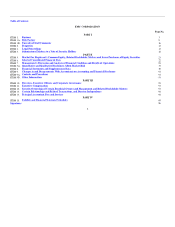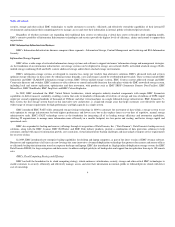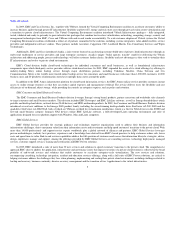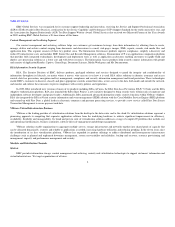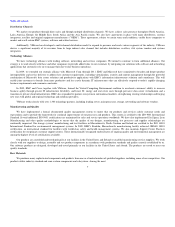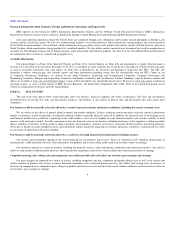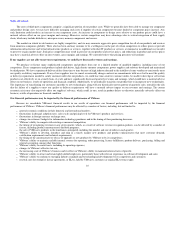EMC 2009 Annual Report Download - page 13
Download and view the complete annual report
Please find page 13 of the 2009 EMC annual report below. You can navigate through the pages in the report by either clicking on the pages listed below, or by using the keyword search tool below to find specific information within the annual report.
Table of Contents
Companies may develop new technologies or products in advance of us or establish business models or technologies disruptive to us. Our business may
be materially adversely affected by the announcement or introduction of new products, including hardware and software products and services by our
competitors, and the implementation of effective marketing or sales strategies by our competitors. The material adverse effect to our business could include a
decrease in demand for our products and services and an increase in the length of our sales cycle due to customers taking longer to compare products and
services and to complete their purchases.
We may have difficulty managing operations.
Our future operating results will depend on our overall ability to manage operations, which includes, among other things:
• retaining and hiring, as required, the appropriate number of qualified employees;
• managing, protecting and enhancing, as appropriate, our infrastructure, including but not limited to, our information systems and internal controls;
• accurately forecasting revenues;
• training our sales force to sell more software and services;
• successfully integrating new acquisitions;
• managing inventory levels, including minimizing excess and obsolete inventory, while maintaining sufficient inventory to meet customer demands;
• controlling expenses;
• managing our manufacturing capacity, real estate facilities and other assets; and
• executing on our plans.
An unexpected decline in revenues without a corresponding and timely reduction in expenses or a failure to manage other aspects of our operations
could have a material adverse effect on our business, results of operations or financial condition.
Our investment portfolio could experience a decline in market value which could adversely affect our financial results.
We held $3.1 billion in short and long-term investments as of December 31, 2009. The investments are invested primarily in investment grade debt
securities, and we limit the amount of investment with any one issuer. A further deterioration in the economy, including a continuing credit crisis, increased
defaults by issuers, or significant volatility in interest rates, could cause the investments to decline in value or could impact the liquidity of the portfolio. If
market conditions deteriorate significantly, our results of operations or financial condition could be materially adversely affected.
If our cost reduction and management measures are not successful, our business could be adversely affected.
A variety of factors could prevent us from achieving our goal of better aligning our revenues and cost structure. While we have achieved savings in
2009 from our cost savings initiatives, there is no assurance that we will be able to continue to achieve additional savings in 2010. Additionally, we may
determine that the costs of implementing reductions outweigh the commensurate benefits. Should we implement certain cost reductions, there could be
adverse consequences on our business which could have a material adverse effect on our results of operations or financial position.
Our business may suffer if we are unable to retain or attract key personnel.
Our business depends to a significant extent on the continued service of senior management and other key employees, the development of additional
management personnel and the hiring of new qualified employees. There can be no assurance that we will be successful in retaining existing personnel or
recruiting new personnel. The loss of one or more key or other employees, our inability to attract additional qualified employees or the delay in hiring key
personnel could have a material adverse effect on our business, results of operations or financial condition.
Our quarterly revenues and earnings could be materially adversely affected by uneven sales patterns and changing purchasing behaviors.
Our quarterly sales have historically reflected an uneven pattern in which a disproportionate percentage of a quarter's total sales occur in the last month
and weeks and days of each quarter. This pattern makes prediction of revenues, earnings and working capital for each financial period especially difficult and
uncertain and increases the risk of unanticipated variations in quarterly results and financial condition. We believe this uneven sales pattern is a result of many
factors including:
• the relative dollar amount of our product and services offerings in relation to many of our customers' budgets, resulting in long lead times for
customers' budgetary approval, which tends to be given late in a quarter;
12


